
Nepticulidae is a family of very small moths with a worldwide distribution. They are characterised by eyecaps over the eyes. These pigmy moths or midget moths, as they are commonly known, include the smallest of all living moths, with a wingspan that can be as little as 3 mm in the case of the European pigmy sorrel moth, but more usually 3.5–10 mm. The wings of adult moths are narrow and lanceolate, sometimes with metallic markings, and with the venation very simplified compared to most other moths.
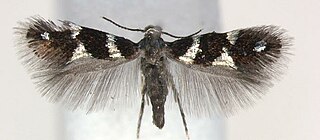
The Heliozelidae, commonly known as shield-bearer moths, are a family of small, day flying monotrysian moths distributed worldwide. The larvae of most heliozelid species are leaf miners who cut distinctive shield-shaped cases from the surface of the host leaf, hence the common name. Some species are considered pests of commercial crops such as grapevines, cranberries, and walnuts. The taxonomy of this family is poorly understood.

Ectoedemia minimella is a moth of the family Nepticulidae. It is widely distributed in the Holarctic.
Stigmella populnea is a moth of the family Nepticulidae. It is only known from Hokkaido in Japan.

Stigmella sophorae is a moth of the family Nepticulidae. It is found in New Zealand.
Stigmella tricentra is a moth of the family Nepticulidae. It is found in New Zealand.

Fomoria pteliaeella is a moth of the family Nepticulidae. It is found in Kentucky and Ohio in the United States.

Zimmermannia bosquella is a moth of the family Nepticulidae. It is found in Virginia, Ohio, and Kentucky in the United States. It is now classified as conspecific with the American chestnut moth, which was formerly considered as extinct.

Antispila isabella is a species of moth of the family Heliozelidae. It is found in Ontario, Connecticut, Georgia, Kentucky, New York, Pennsylvania and Vermont. However, research concludes that a complex of species is involved under this name.

Antispila argostoma is a moth of the family Heliozelidae. It was described by Edward Meyrick in 1916. It is found in India.
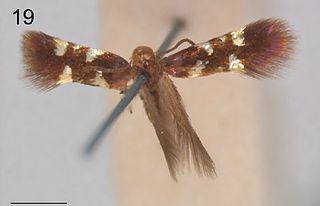
Antispila aristarcha is a moth of the family Heliozelidae. It was described by Edward Meyrick in 1916. It is found in India.

Holocacista micrarcha is a moth of the family Heliozelidae. It was described by Edward Meyrick in 1926. It is found in India.

Antispila uenoi is a moth of the family Heliozelidae. It was described by Kuroko in 1987. It is found in Japan. In 2018, the species was found from China.
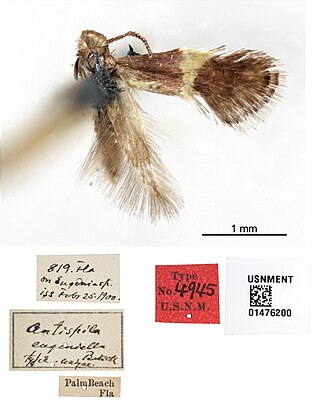
Heliozela eugeniella is a species of moth in the family Heliozelidae. It was described by August Busck in 1900 and is known only from Florida.

Aspilanta argentifera is a species of moth in the family Heliozelidae, first described by Annette Frances Braun in 1927. It is found in eastern North America. The larvae are leaf miners that feed on several species of plant in the family Myricaceae.
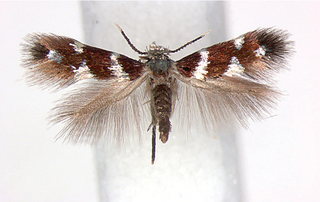
Aspilanta hydrangaeella is a species of moth in the family Heliozelidae. It is found in the United States. The larvae are leaf miners that feed on hydrangea plants.
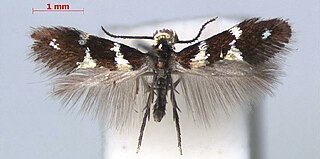
Aspilanta oinophylla is a species of moth in the family Heliozelidae. It is native to North America and is an introduced species in Italy. The larvae are leaf miners that feed on several species of Vitaceae, including commercially important species of grapevine.

Aspilanta viticordifoliella is a species of moth in the family Heliozelidae. It is found in eastern North America. The larvae are leaf miners that feed on Virginia creeper, false Virginia creeper, and frost grape.

Aspilanta voraginella is a species of moth in the family Heliozelidae, first described by Annette Frances Braun in 1927. It is found in the United States. The larvae are leaf miners that feed on Vitis arizonica.

Aspilanta is a genus of very small moths in the family Heliozelidae that is native to North America. The larvae are leaf miners. Most Aspilanta species feed on Vitaceae with the exception of A. hydrangaeella and A. argentifera, which feed on species of hydrangea and Myricaceae respectively. The name of the genus is a partial anagram of Antispila.


















